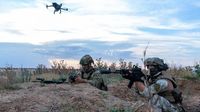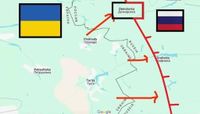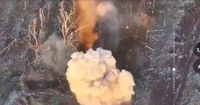In a significant escalation of military conflict, the Ukrainian Armed Forces (VSU) have reportedly breached the state border and entered the village of Demidovka in the Belgorod region. This incursion, confirmed by Russian military expert Yuri Kotenok on the morning of March 24, showcases the ongoing tensions in the area as fighting has erupted between the two opposing sides.
According to Kotenok, "Groups of the enemy managed to break through to the southern outskirts of Demidovka. Fighting is taking place in the village." This hostile activity follows reports from the Institute for the Study of War (ISW) indicating that Ukrainian defense forces had advanced into the Belgorod region in recent days, although uncertainties persist regarding their ability to maintain control over these positions.
As the conflict continues, Russian state media have noted that their forces are actively expanding their control zone near Basovka in the Sumy region. Concurrently, fighting is reported in areas surrounding Demidovka, including the regions of Guev, Gornal, and Oleshnya. The Russian military appears determined to maintain the offensive against the Ukrainian forces, which are reportedly trying to stave off advancements.
In the days leading up to this reported breach, Russian sources indicated that Ukrainian forces had gathered significant manpower near the village of Marino in the Sumy region, preparing to launch operations in the forest belts adjacent to Demidovka. It has been observed that equipment deployed by the VSU has primarily been utilized for transporting troops to the frontline, as they execute their attacks primarily through infantry maneuvers.
Despite these efforts, Ukrainian forces have faced considerable difficulties in making gains in the Belgorod border area. A military briefing referred to by URA.RU suggests that, "The enemy has not been able to achieve any noticeable success in this area," highlighting the challenging operational conditions Ukrainian troops face as they continue their offensives.
This ongoing battle for Demidovka marks a notable chapter in the broader conflict that has persisted in the region for years. The Russian army, utilizing special forces and tactical units, has been engaged in robust efforts to repel Ukrainian advances. According to military sources, "We pushed the enemy out of Demidovka. The special forces 'Akhmat', 155th brigade, and GRU special forces participated in the operation," which underscores the scale and seriousness of the combat operation taking place.
However, the situation remains fluid. Russian forces are reportedly conducting sweeps in and around Demidovka to clear any remaining Ukrainian fighters who may still be active in the area. As these military actions unfold, there are indications that Ukrainian troops continue trying to consolidate positions while regrouping for further assaults.
One of the contributing factors to this ongoing engagement appears to be logistical challenges faced by the Russian military. A source has explained that issues with communication and coordination among Russian units had allowed Ukrainian forces a temporary breakthrough into the Belgorod region. "The reason for Ukraine's breakthrough under Belgorod was insufficient interaction and communication problems between Russian units," the source noted, bringing attention to a systemic issue that has impacted the operational effectiveness of Russian forces during this conflict.
As the fighting continues, both forces seem engaged in a back-and-forth struggle for control in this strategic region. Although recent reports indicate that Ukrainian attempts to penetrate deeper into Russian-held territory have stalled, the military landscape remains volatile with sporadic engagements anticipated in the coming days.
With large numbers of troops deployed and significant military assets engaged, the battle for Belgorod—and specifically Demidovka—represents not only a tactical confrontation but also a deeper test of resolve for both nations. As these military operations persist, they shed light on the high-stakes nature of this ongoing conflict and the challenges that lie ahead for both sides in their respective campaigns.




